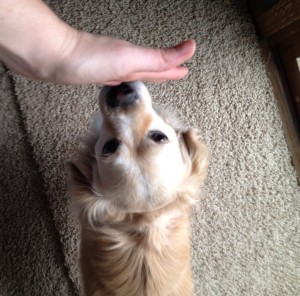Austin Dog Zone formed in 2011. We offer dog training for all breeds and temperaments. We are committed to staying up-to-date on the most current scientific research available for dogs regarding both behavior and wellness. Our methods are effective, dog-friendly and family friendly.
This story inspired me to write about some of the common jargon an unassuming person may hear when looking for a dog trainer. As with anything that creates controversy, or allows for multiple opinions, dog training is right up there on the list of hot topics. There are a colorful spectrum of opinions on it. The point of this blog post is to help you decipher exactly what is happening before, or when you sign up with a trainer that may be using methods that did not originally line up with what you thought. I would also hope it would bring awareness too. The situations below happen frequently and are more than unfortunate. Your dog deserves better and you deserve better.
What they are commonly called instead to potential clients:
e-collars, remote collars, electronic dog collars
All are synonymous for a shock collar. An electronic shock is administered to your dog by the push of a button that you control. You can change the settings to make the shock more, or less intense. People with very little to no experience are told to go out and buy a shock collar to continue their training and to use it when the dog does something they do not like. People have a hard enough time rewarding dogs in a timely manner that is understanding to the dog, I can’t imagine what it must be like for the average dog owner doing this. I’ve seen what this has done in the wrong hands. The reason it is popular is because it makes the dog obey in an almost robotic fashion.
Some companies market it as a “tap on the shoulder” to your dog, or a vibration to get their attention. That is simply not true. The settings are lowered when they allow an apprehensive person to try it on themselves and turned up as soon as it is put back on the dog. We have seen burn marks on the necks of dogs that have been shocked repeatedly at a high setting. I’ve spoken with vets who have refused to treat dogs that trainers have brought in with these injuries from their abuse (without the owner’s knowledge).
I was speaking with someone the other day and she joked with me that she was corrected when she was talking to a gentleman walking his dog with a shock collar. The person sternly said, “No, this is a remote collar!”. The person was sold on words that were shared with him. It made him upset when someone told him he was using a shock collar. A simple change of words made the use of a shock collar acceptable to him.
Taken from a website of a company that puts shock collars on puppies and fearful dogs, their message states, “Happy and confident dogs trained positively.” If an unsuspecting person was browsing, it sounds pretty good, don’t you think? In the pictures, you see a collar that looks a little bigger than usual and a handler carrying what looks like a remote control, but may not recognize exactly what it is. This is where an unsuspecting person with good intentions can put their dogs in bad situations.
 Prong Collars and Choke Collars
Prong Collars and Choke Collars
The biggest problem I have with these is that people use them improperly and often fit them incorrectly. Maybe you’ve seen it at your local pet retail store, prong collars so loose they are hanging off the dog’s neck, a choke chain so tight that the dog is pulling its owner all over the place and choking itself repeatedly (and it isn’t working on the leash pulling either!). I would hope you haven’t seen it, but prong collars can also puncture the skin (see picture) and leave holes in a dog’s neck when improperly fitted and used in a forceful manner/correction. Again, the average dog owner does not have fast enough reflexes, nor is experienced enough for this type of tool when there are far better alternatives available that do not pose a risk to your dog.
That being said, a Gentle Leader can cause damage to a dog if it is worn improperly or is not fitted. Please feel free to contact us with alternatives to prong and choke collars. We’d be happy to speak with you. Prong collars and choke collars go directly hand-in-hand with leash corrections. *Just because a trainer is using a metal collar does not mean they are abusing it, but it can go downhill fast in the wrong hands.*
Leash Corrections
What they are commonly called instead to potential clients/clients:
“a pop” on the collar, a snap
Forceful jerks to your dog’s neck are justified by bad advice and zero facts, “What a mother dog would do to her pups to correct them..”, is often said to a client. The biggest problem with this is how out of control it can get in a hurry and how ineffective it is. A “pop” turns into a forceful jerk, which can turn into increased violence rather quickly. Human beings have tempers and our dogs frustrate us sometimes. Allowing and accepting this type of behavior to punish our dogs is unacceptable. If a “trainer” is freely giving these corrections in front of you, imagine what they may be doing when you aren’t present! That brings me to my next and final point.
Boot Camps
“Get a Trained Dog in 20 Days, Guaranteed!” We’ve all seen it for people (hello crash diets), but of course these quick fixes are advertised for dog owners too. Many companies have you drop your dog off for one week or more with little to no information about their methods. People are drawn to the quick fix and don’t realize that their dog is getting beat, smacked, hung and shocked when it doesn’t do what they want. Does that mean all places that advertise these services are like that? Absolutely not, but be leery of companies that guarantee results and quick fixes.
A few ways to avoid the above problems:
-do your research
-attend/observe classes to check the behavior of the dogs in class, the tools used and the instructor’s methods
Are the dogs acting like robots, or are they happily listening to the next task at hand?
-ask questions
-if you feel uncomfortable with any method used on your dog during a training session, speak up about it and stop it
All too often we assume that the “professional” knows best and we avoid what our gut is telling us when we are feeling uneasy.
This is simply scratching the surface to what happens daily in the dog world. Dog training has come a long way, but we still have much progress to make. I hope that this post has been helpful and informative to those of you who are seeking help for your dog. We encourage you to look into science based, positive training methods that do not involve force. To learn more about that, click here. If you’re curious about studying the side effects of shock collars and the other aversive methods above, go here. As always, if you have any questions, feel free to email us.
Post Written By: Laura Neiheisel
 We hear this question a lot: “Why does my dog only listen to ____(insert any applicable family member)?”
We hear this question a lot: “Why does my dog only listen to ____(insert any applicable family member)?”
Dogs thrive on consistent, fair leadership. Family members who are present and offer fun, rewarding activities such as daily walks, or food automatically have stars and rainbows coming from their head in a dog’s mind. “This person is valuable to my survival.” However, it doesn’t stop there. You may be the person that feeds the dog daily, but if you are not asking for any behaviors from the dog during this time, Fido may not still listen right away when you ask. Below are several tips on how to improve your canine’s listening skills and engagement with you!
1. Be consistent and take an active role in their lives. Do you feed your dog as soon as you get home? Incorporate some training in the process. Ask your dog to sit, or wait before feeding (after you’ve properly taught what this word means). We are big believers that “Nothing in Life is Free” for our canine friends and that they must work to receive what they want.
2. Be fun! Take the dog on fun trips, or a walk/run. I can guarantee that your dog will absolutely worship the ground you stand on when you come home. Often times after engaging activities, dogs will keep following you from room to room, waiting to see what fun thing you will have next. What a perfect time to practice more listening skills. 🙂
3. Go to a training class. If your dog particularly has selective hearing with you, try a positive training class! You are suddenly the source of all good things, whether it be food, or their favorite motivator (toy, etc).
4. Be fair. Do not get angry easily with your dog. A human who is quick to yell, or be violent with their dog only looks unpredictable and scary in a dog’s mind.
5. Have patience and set realistic expectations. Some breeds of dog naturally bond to one person mainly in the home (particularly herding breeds), but that doesn’t mean they have to have selective hearing with you. Try these tips and see what happens!
Post By: Laura Neiheisel
 Meet Attila while on a food high in grains, artificial colors and preservatives. Her food was also deficient in high quality protein sources, so she wasn’t thriving on her old diet. She sometimes dug at her skin and itched. If you look closely at her picture, you can see the pink irritation in her skin.
Meet Attila while on a food high in grains, artificial colors and preservatives. Her food was also deficient in high quality protein sources, so she wasn’t thriving on her old diet. She sometimes dug at her skin and itched. If you look closely at her picture, you can see the pink irritation in her skin.
Fast track to now and her skin is already less irritated on a better quality food and the itching has completely stopped! Does your dog have chronic ear infections, itchy/dry skin, or irritated skin? Check the food! If you have questions about this, feel free to contact us to learn more. We are passionate about your dog’s nutrition and truly believe food matters.
Related Posts:
Decoding Pet Food Labels
Recently, we asked on our facebook page if anyone had a specific behavioral or training question. We received some great questions. Lesley M’s chosen question was, “Why does my dog growl and bite at her sister when she sees another dog?”
Your Dog’s Mind When He Passes His Threshold
When a dog becomes fixated on a stimulus, such as another dog on the side of the street, his mind cannot think clearly until that trigger is out of sight, or reach. You might see it in his body. He becomes incredibly tense and focused, like a ticking time bomb. He no longer listens or even hears you. And if he can’t get to what is bothering him, the slightest touch from you (and sometimes even your presence), or another family pet within reach, can be on the receiving end of that pent up tension and frustration. The dog sometimes redirects this in the form of aggression towards a handler, or in this case another family dog.
What Your Dog Isn’t Thinking
Unfortunately, our human brains are bewilderedly thinking, can’t my dog see that that is her sibling, or MY arm he’s biting?! The answer is, no, not at that point. Your dog’s adrenaline and stress responses are off the charts and the best thing you could possibly do is remove him from the situation as safely and quickly as you can.
What Training Can Do
The goal of training a dog like this is that we slowly desensitize the dog, while rewarding calm and casual behaviors. The dog gets what he wants, which may be more space away from his trigger initially, or a high value treat, or toy while learning alternative behaviors that we want. Ultimately, this also involves a more positive association with the stimulus that once triggered aggression. Example of a goal: casually walking by another dog while out on walks.
Effective training cannot happen when a dog is past its personal threshold, or breaking point. That should be called “damage control.” Physical corrections are also ineffective. Physical corrections before and particularly AFTER the dog responds in a way that we do not want (lunging, barking, biting) simply says, “Yes, keep that up, that object IS harmful and worth your reaction.” It may at first stop the dog, suppress the negative reaction, or at worst make the dog even more reactive. It simply does not allow the dog to see this trigger object in a new light, but continually reinforces his bad behavior.
If you have questions, or need help, please contact us.
Related Posts:
“My Dog Would Never Bite..”
How to Properly Break up a Dog Fight
Help Your Leash Reactive Dog Find Peace on Leash
Written By: Laura Neiheisel
 Learn why and how to use hand targeting with your dog
Learn why and how to use hand targeting with your dog
Got something to say to your dog? Let your hands do the talking!
“Touch” is a targeting skill that occurs when a dog moves from wherever they are to a specific area (your hand). “Touch” is marked by the dog firmly pressing the end of their muzzle to the flat, open palm of the person that engages with them.
Most every dog can learn and perform “Touch” with ease. Your dog needn’t be in an advanced obedience class to learn it, in fact, puppies often pick up on this skill in a matter of seconds. Shy dogs, hyper dogs, goofy dogs, you name it, they can all acquire this skill. The reason it works well because we are taking advantage of every dog’s natural desire to explore, experiment and pursue new opportunities; every time a dog does “Touch,” they are being presented an opportunity for something they perceive rewarding from their person.
All you need to teach Touch is an outstretched hand and several small bits of treats or tasty kibble (however, I recommend using high value treats that follow the Three S rule: Small, Soft & Stinky!) Always keep the treats in the hand opposite of the Touch hand. When your dog approaches your hand and noses the end of it, happily say “Yes” and immediately give them a single treat. Repeat this several times, moving your hand placement from side to side each time, or by walking away from your dog in order to spark their interest. Many dogs cannot resist a good game of chase or tag, so many people find their dogs’ energy and enthusiasm to touch the hand target increases faster this way.
There are many different uses for hand targeting, but here are some of the best:
1) To call your dog close to you, or briefly “check in” with you when they are off-leash
2) When puppies and small dogs jump up, have them target your hand away from your body and lower to the ground (to redirect and reinforce all four paws on the floor).
3) A helpful tool when training leash walking and heeling; your hand is a point of reference for your dog to follow until these skills become more consistent and reliable.
4) To promote positive associations with the presence of hands–an especially useful tool in raising puppies and shy dogs to feel more confident and safe as new people outstretch their hands to greet the dog.
5) To redirect, interrupt or distract your dog from doing unwanted behavior, such as hard staring or barking at other dogs.
Hand targeting–just like sit, stay or fetch–should be a job or task for your dog to complete in order to receive something positive and valuable to them. Be sure to offer your dog a reward at a value that matches the level of difficulty within the context it was used so the skill remains strong and reliable. In other words, when your dog engages in hand targeting with several distractions and temptations present, be sure to provide a reward that is of high value to your dog in that occasion. When your dog can perform Touch comfortably without many distractions, it’s better to give lower value rewards or only reward for the very best responses (i.e. the fastest).
Have questions? Feel free to contact us.
Written by: Caitlin Lane, CPDT-KA
